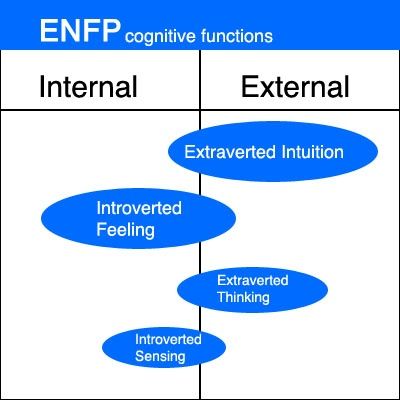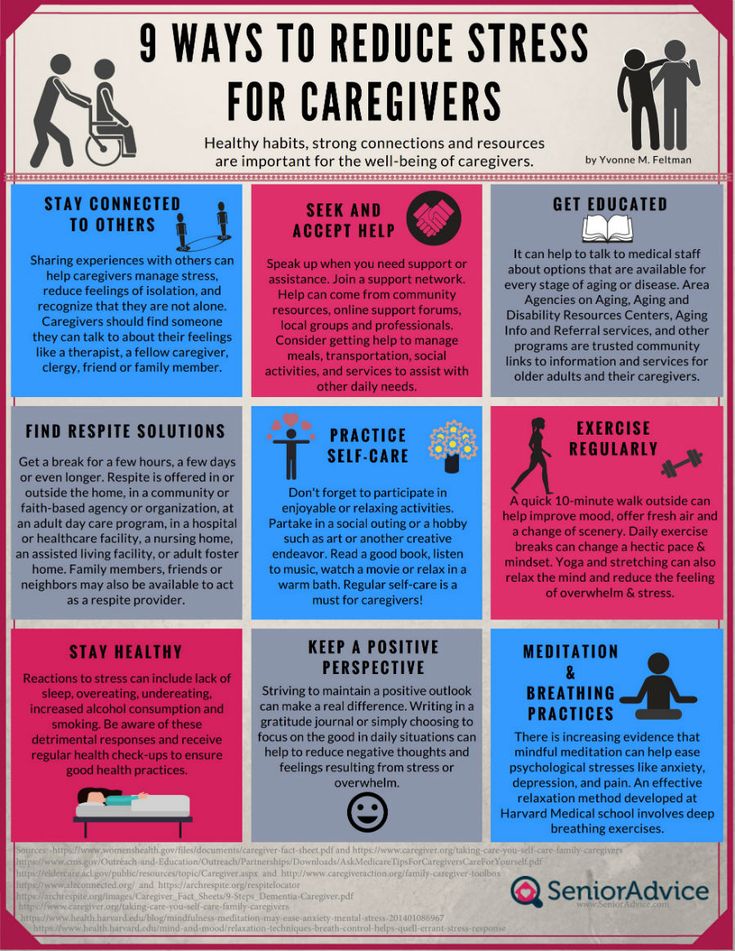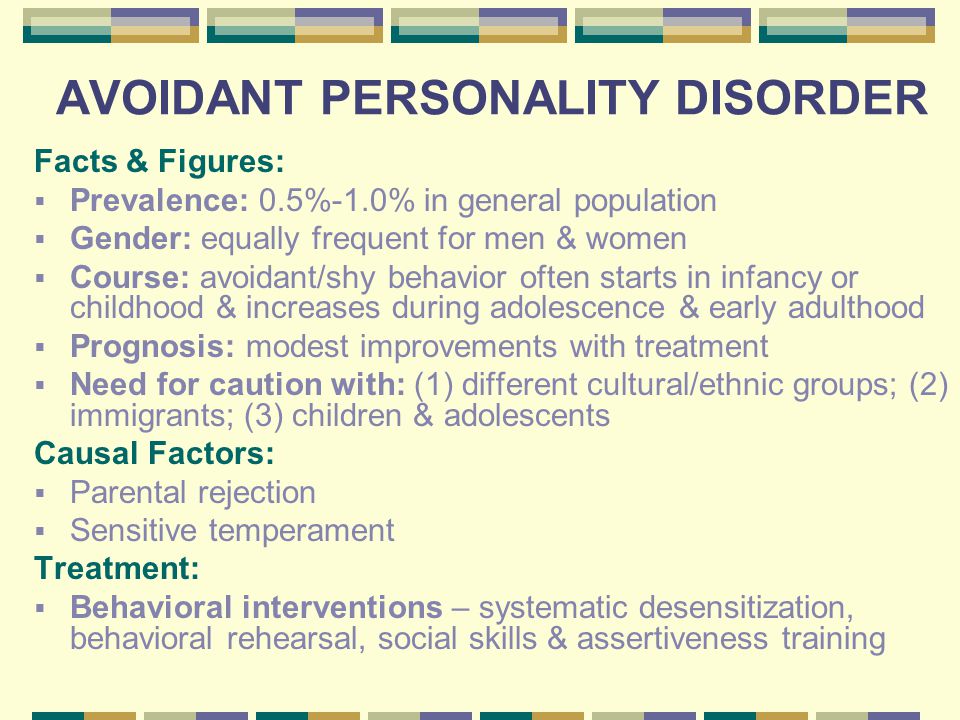Type 1 and 2 bipolar disorder
Bipolar 1 vs. Bipolar 2: Know the Difference
Understanding bipolar disorder
Most people have emotional ups and downs from time to time. But if you have a brain condition called bipolar disorder, your feelings can reach abnormally high or low levels.
Sometimes you may feel immensely excited or energetic. Other times, you may find yourself sinking into a deep depression. Some of these emotional peaks and valleys can last for weeks or months.
There are four basic types of bipolar disorder:
- bipolar 1 disorder
- bipolar 2 disorder
- cyclothymic disorder (cyclothymia)
- other specified and unspecified bipolar and related disorders
Bipolar 1 and 2 disorders are more common than the other types of bipolar disorder. Read on to learn how these two types are alike and different.
All types of bipolar disorder are characterized by episodes of extreme mood. The highs are known as manic episodes. The lows are known as depressive episodes.
The main difference between bipolar 1 and bipolar 2 disorders lies in the severity of the manic episodes caused by each type.
A person with bipolar 1 will experience a full manic episode, while a person with bipolar 2 will experience only a hypomanic episode (a period that’s less severe than a full manic episode).
A person with bipolar 1 may or may not experience a major depressive episode, while a person with bipolar 2 will experience a major depressive episode.
What is bipolar 1 disorder?
You must have had at least one manic episode to be diagnosed with bipolar 1 disorder. A person with bipolar 1 disorder may or may not have a major depressive episode. The symptoms of a manic episode may be so severe that you require hospital care.
Manic episodes are usually characterized by the following:
- exceptional energy
- restlessness
- trouble concentrating
- feelings of euphoria (extreme happiness)
- risky behaviors
- poor sleep
The symptoms of a manic episode tend to be so obvious and intrusive that there’s little doubt that something is wrong.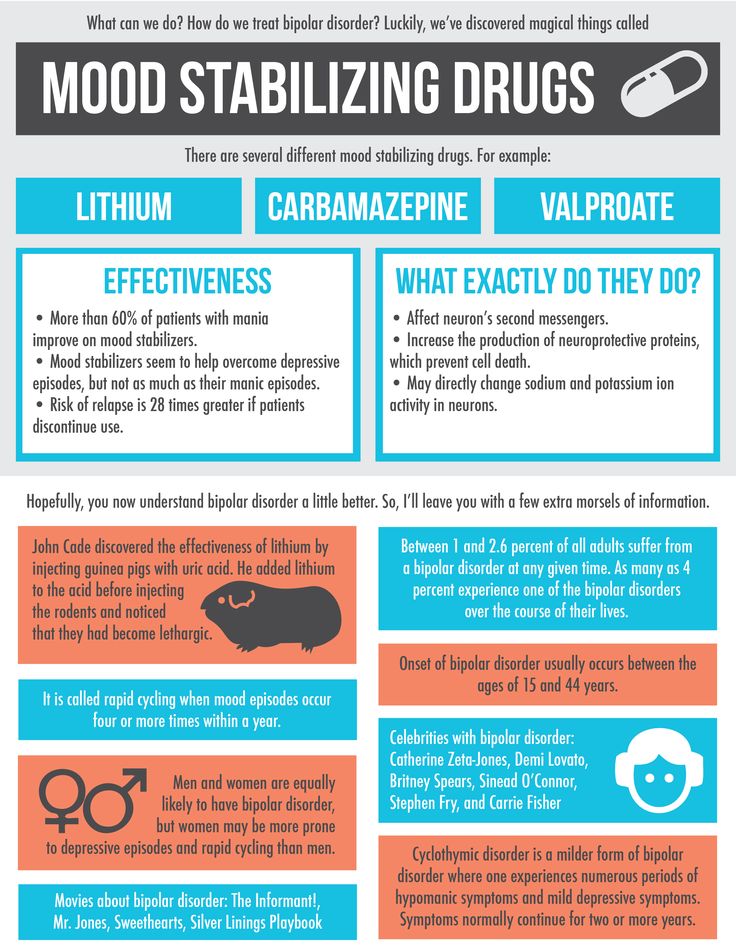
What is bipolar 2 disorder?
Bipolar 2 disorder involves a major depressive episode lasting at least two weeks and at least one hypomanic episode (a period that’s less severe than a full-blown manic episode). People with bipolar 2 typically don’t experience manic episodes intense enough to require hospitalization.
Bipolar 2 is sometimes misdiagnosed as depression, as depressive symptoms may be the major symptom at the time the person seeks medical attention. When there are no manic episodes to suggest bipolar disorder, the depressive symptoms become the focus.
As mentioned above, bipolar 1 disorder causes mania and may cause depression, while bipolar 2 disorder causes hypomania and depression. Let’s learn more about what these symptoms mean.
Mania
A manic episode is more than just a feeling of elation, high energy, or being distracted. During a manic episode, the mania is so intense that it can interfere with your daily activities. It’s difficult to redirect someone in a manic episode toward a calmer, more reasonable state.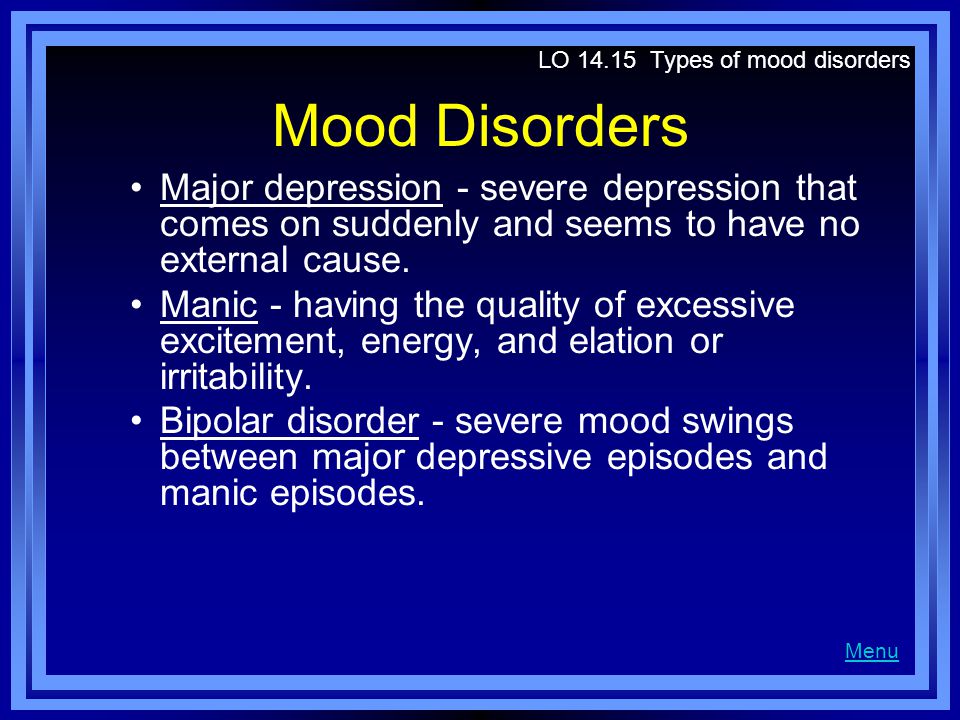
People who are in the manic phase of bipolar disorder can make some very irrational decisions, such as spending large amounts of money that they can’t afford to spend. They may also engage in high-risk behaviors, such as sexual indiscretions despite being in a committed relationship.
An episode can’t be officially deemed manic if it’s caused by outside influences such as alcohol, drugs, or another health condition.
Hypomania
A hypomanic episode is a period of mania that’s less severe than a full-blown manic episode. Though less severe than a manic episode, a hypomanic phase is still an event in which your behavior differs from your normal state. The differences will be extreme enough that people around you may notice that something is wrong.
Officially, a hypomanic episode isn’t considered hypomania if it’s influenced by drugs or alcohol.
Depression
Depressive symptoms in someone with bipolar disorder are like those of someone with clinical depression.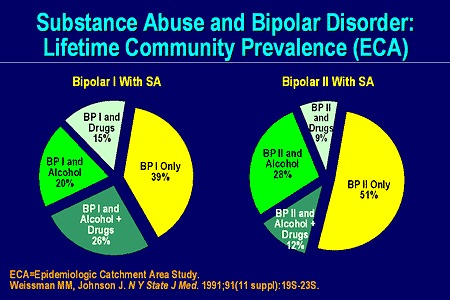 They may include extended periods of sadness and hopelessness. You may also experience a loss of interest in people you once enjoyed spending time with and activities you used to like. Other symptoms include:
They may include extended periods of sadness and hopelessness. You may also experience a loss of interest in people you once enjoyed spending time with and activities you used to like. Other symptoms include:
- tiredness
- irritability
- trouble concentrating
- changes in sleeping habits
- changes in eating habits
- thoughts of suicide
Scientists don’t know what causes bipolar disorder. Abnormal physical characteristics of the brain or an imbalance in certain brain chemicals may be among the main causes.
As with many medical conditions, bipolar disorder tends to run in families. If you have a parent or sibling with bipolar disorder, your risk of developing it is higher. The search continues for the genes which may be responsible for bipolar disorder.
Researchers also believe that severe stress, drug or alcohol abuse, or severely upsetting experiences may trigger bipolar disorder. These experiences can include childhood abuse or the death of a loved one.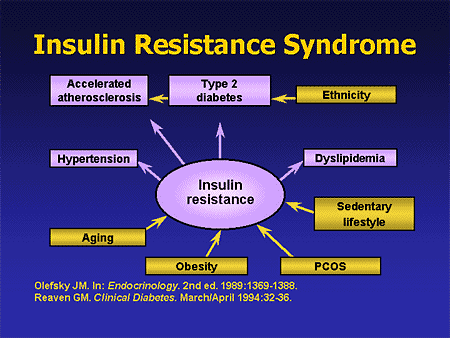
A psychiatrist or other mental health professional typically diagnoses bipolar disorder. The diagnosis will include a review of both your medical history and any symptoms you have that are related to mania and depression. A trained professional will know what questions to ask.
It can be very helpful to bring a spouse or close friend with you during the doctor’s visit. They may be able to answer questions about your behavior that you may not be able to answer easily or accurately.
If you have symptoms that seem like bipolar 1 or bipolar 2, you can always start by telling your doctor. Your doctor may refer you to a mental health specialist if your symptoms appear serious enough.
A blood test may also be part of the diagnostic process. There are no markers for bipolar disorder in the blood, but a blood test and a comprehensive physical exam may help rule out other possible causes for your behavior.
Doctors usually treat bipolar disorder with a combination of medications and psychotherapy.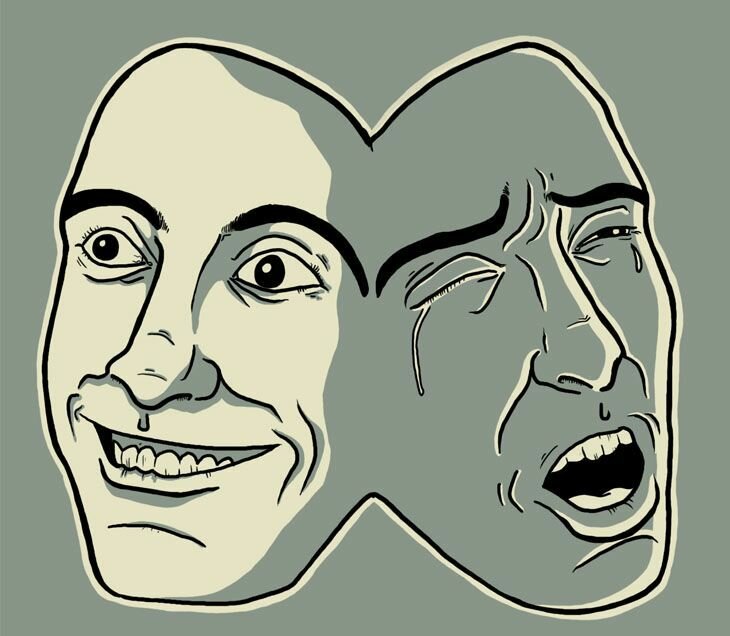
Mood stabilizers are often the first drugs used in treatment. You may take these for a long time.
Lithium has been a widely used mood stabilizer for many years. It does have several potential side effects. These include low thyroid function, joint pain, and indigestion. It also requires blood tests to monitor therapeutic levels of the drug as well as kidney function. Antipsychotics can be used to treat manic episodes.
Your doctor may start you on a low dose of whichever medication you both decide to use in order to see how you respond. You may need a stronger dose than what they initially prescribe. You may also need a combination of medications or even different medications to control your symptoms.
All medications have potential side effects and interactions with other drugs. If you’re pregnant or you take other medications, be sure to tell your doctor before taking any new medications.
Writing in a diary can be an especially helpful part of your treatment. Keeping track of your moods, sleeping and eating patterns, and significant life events can help you and your doctor understand how therapy and medications are working.
Keeping track of your moods, sleeping and eating patterns, and significant life events can help you and your doctor understand how therapy and medications are working.
If your symptoms don’t improve or get worse, your doctor may order a change in your medications or a different type of psychotherapy.
Online therapy options
Read our review of the best online therapy options to find the right fit for you.
Bipolar disorder isn’t curable. But with proper treatment and support from family and friends, you can manage your symptoms and maintain your quality of life.
It’s important that you follow your doctor’s instructions regarding medications and other lifestyle choices. This includes:
- alcohol use
- drug use
- exercise
- diet
- sleep
- stress reduction
Including your friends and family members in your care can be especially helpful.
It’s also helpful to learn as much as you can about bipolar disorder. The more you know about the condition, the more in control you may feel as you adjust to life after diagnosis.
The more you know about the condition, the more in control you may feel as you adjust to life after diagnosis.
You may be able to repair strained relationships. Educating others about bipolar disorder may make them more understanding of hurtful events from the past.
Support groups, both online and in person, can be helpful for people with bipolar disorder. They can also be beneficial for your friends and relatives. Learning about others’ struggles and triumphs may help you get through any challenges you may have.
The Depression and Bipolar Support Alliance maintains a website that provides:
- personal stories from people with bipolar disorder
- contact information for support groups across the United States
- information about the condition and treatments
- material for caregivers and loved ones of those with bipolar disorder
The National Alliance on Mental Illness can also help you find support groups in your area. Good information about bipolar disorder and other conditions can also be found on its website.
If you’ve been diagnosed with bipolar 1 or bipolar 2, you should always remember that this is a condition you can manage. You aren’t alone. Talk to your doctor or call a local hospital to find out about support groups or other local resources.
Bipolar 1 vs. Bipolar 2: Know the Difference
Understanding bipolar disorder
Most people have emotional ups and downs from time to time. But if you have a brain condition called bipolar disorder, your feelings can reach abnormally high or low levels.
Sometimes you may feel immensely excited or energetic. Other times, you may find yourself sinking into a deep depression. Some of these emotional peaks and valleys can last for weeks or months.
There are four basic types of bipolar disorder:
- bipolar 1 disorder
- bipolar 2 disorder
- cyclothymic disorder (cyclothymia)
- other specified and unspecified bipolar and related disorders
Bipolar 1 and 2 disorders are more common than the other types of bipolar disorder. Read on to learn how these two types are alike and different.
Read on to learn how these two types are alike and different.
All types of bipolar disorder are characterized by episodes of extreme mood. The highs are known as manic episodes. The lows are known as depressive episodes.
The main difference between bipolar 1 and bipolar 2 disorders lies in the severity of the manic episodes caused by each type.
A person with bipolar 1 will experience a full manic episode, while a person with bipolar 2 will experience only a hypomanic episode (a period that’s less severe than a full manic episode).
A person with bipolar 1 may or may not experience a major depressive episode, while a person with bipolar 2 will experience a major depressive episode.
What is bipolar 1 disorder?
You must have had at least one manic episode to be diagnosed with bipolar 1 disorder. A person with bipolar 1 disorder may or may not have a major depressive episode. The symptoms of a manic episode may be so severe that you require hospital care.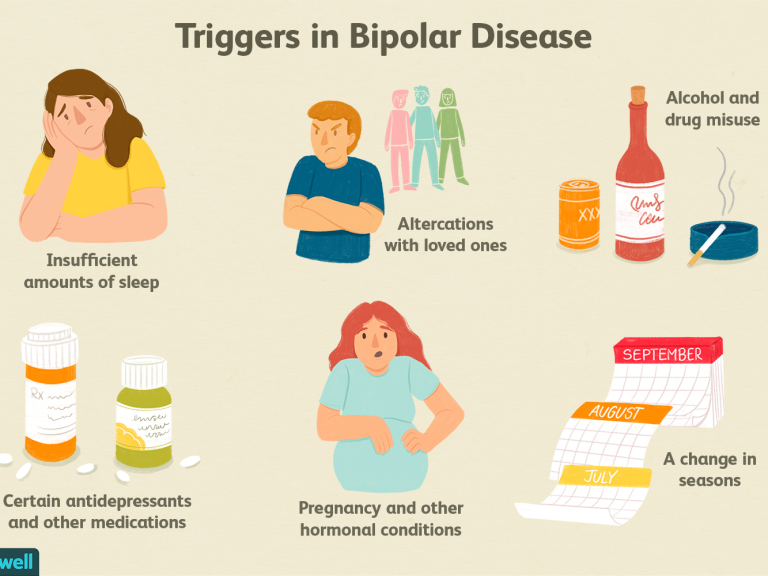
Manic episodes are usually characterized by the following:
- exceptional energy
- restlessness
- trouble concentrating
- feelings of euphoria (extreme happiness)
- risky behaviors
- poor sleep
The symptoms of a manic episode tend to be so obvious and intrusive that there’s little doubt that something is wrong.
What is bipolar 2 disorder?
Bipolar 2 disorder involves a major depressive episode lasting at least two weeks and at least one hypomanic episode (a period that’s less severe than a full-blown manic episode). People with bipolar 2 typically don’t experience manic episodes intense enough to require hospitalization.
Bipolar 2 is sometimes misdiagnosed as depression, as depressive symptoms may be the major symptom at the time the person seeks medical attention. When there are no manic episodes to suggest bipolar disorder, the depressive symptoms become the focus.
As mentioned above, bipolar 1 disorder causes mania and may cause depression, while bipolar 2 disorder causes hypomania and depression.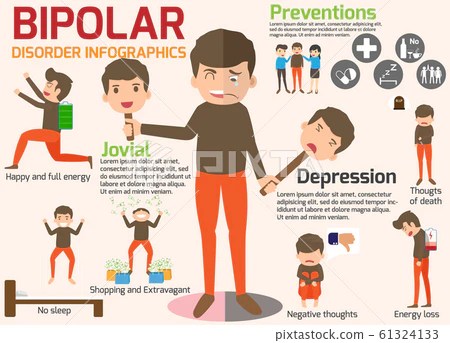 Let’s learn more about what these symptoms mean.
Let’s learn more about what these symptoms mean.
Mania
A manic episode is more than just a feeling of elation, high energy, or being distracted. During a manic episode, the mania is so intense that it can interfere with your daily activities. It’s difficult to redirect someone in a manic episode toward a calmer, more reasonable state.
People who are in the manic phase of bipolar disorder can make some very irrational decisions, such as spending large amounts of money that they can’t afford to spend. They may also engage in high-risk behaviors, such as sexual indiscretions despite being in a committed relationship.
An episode can’t be officially deemed manic if it’s caused by outside influences such as alcohol, drugs, or another health condition.
Hypomania
A hypomanic episode is a period of mania that’s less severe than a full-blown manic episode. Though less severe than a manic episode, a hypomanic phase is still an event in which your behavior differs from your normal state.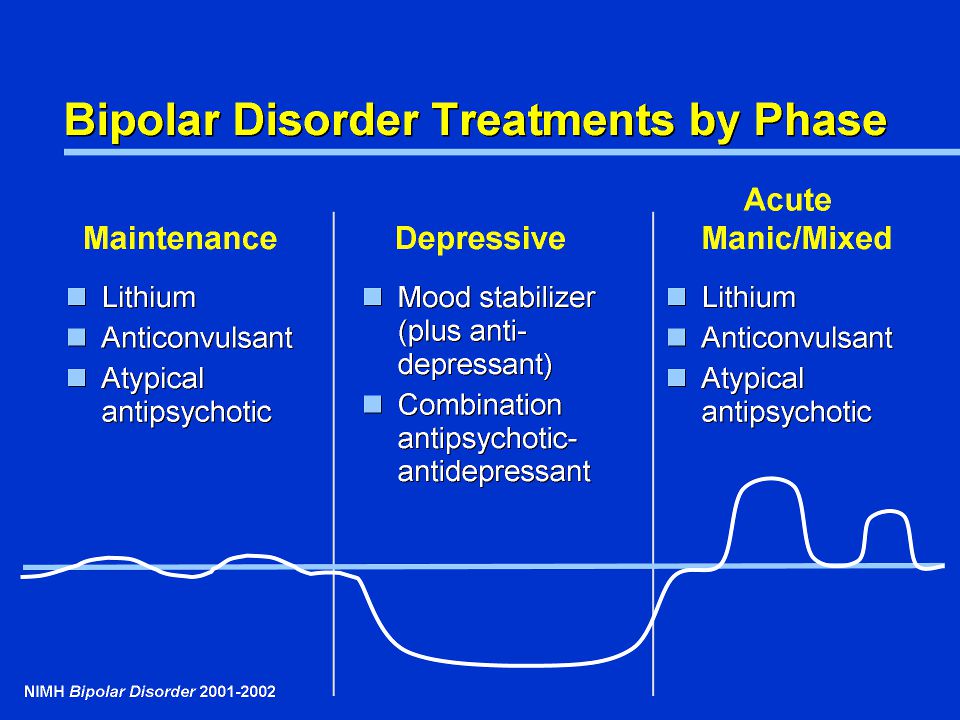 The differences will be extreme enough that people around you may notice that something is wrong.
The differences will be extreme enough that people around you may notice that something is wrong.
Officially, a hypomanic episode isn’t considered hypomania if it’s influenced by drugs or alcohol.
Depression
Depressive symptoms in someone with bipolar disorder are like those of someone with clinical depression. They may include extended periods of sadness and hopelessness. You may also experience a loss of interest in people you once enjoyed spending time with and activities you used to like. Other symptoms include:
- tiredness
- irritability
- trouble concentrating
- changes in sleeping habits
- changes in eating habits
- thoughts of suicide
Scientists don’t know what causes bipolar disorder. Abnormal physical characteristics of the brain or an imbalance in certain brain chemicals may be among the main causes.
As with many medical conditions, bipolar disorder tends to run in families. If you have a parent or sibling with bipolar disorder, your risk of developing it is higher.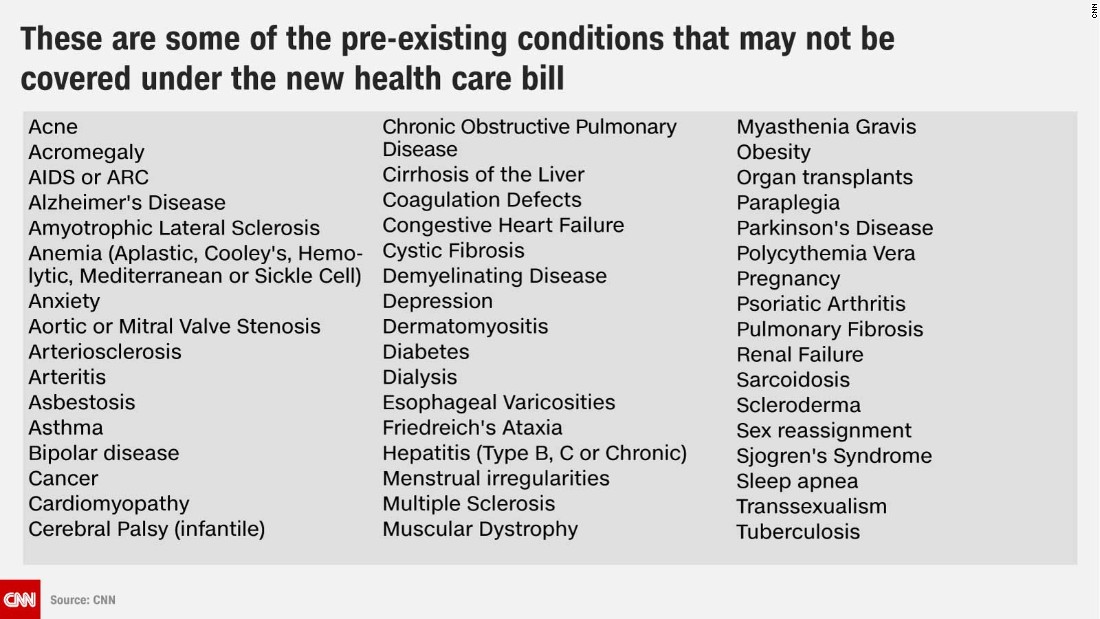 The search continues for the genes which may be responsible for bipolar disorder.
The search continues for the genes which may be responsible for bipolar disorder.
Researchers also believe that severe stress, drug or alcohol abuse, or severely upsetting experiences may trigger bipolar disorder. These experiences can include childhood abuse or the death of a loved one.
A psychiatrist or other mental health professional typically diagnoses bipolar disorder. The diagnosis will include a review of both your medical history and any symptoms you have that are related to mania and depression. A trained professional will know what questions to ask.
It can be very helpful to bring a spouse or close friend with you during the doctor’s visit. They may be able to answer questions about your behavior that you may not be able to answer easily or accurately.
If you have symptoms that seem like bipolar 1 or bipolar 2, you can always start by telling your doctor. Your doctor may refer you to a mental health specialist if your symptoms appear serious enough.
A blood test may also be part of the diagnostic process.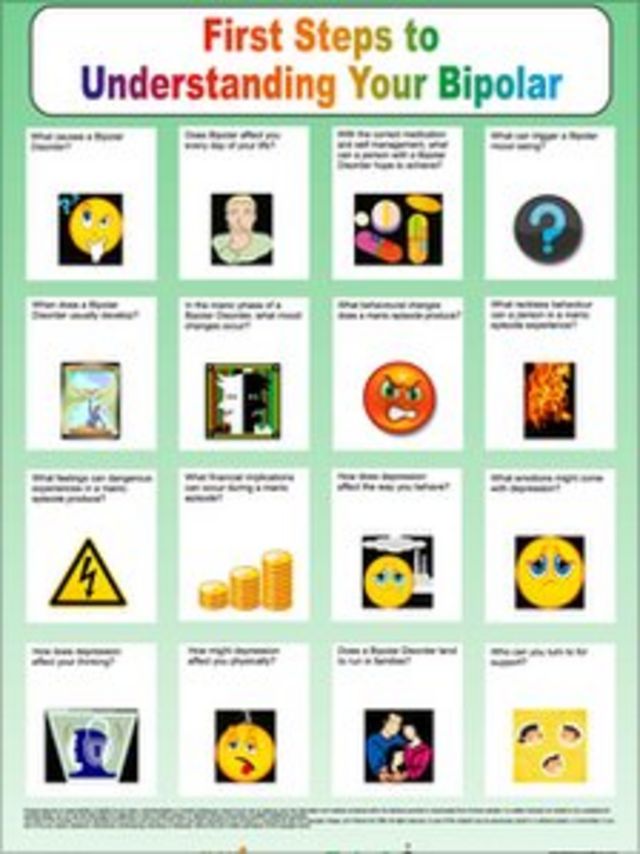 There are no markers for bipolar disorder in the blood, but a blood test and a comprehensive physical exam may help rule out other possible causes for your behavior.
There are no markers for bipolar disorder in the blood, but a blood test and a comprehensive physical exam may help rule out other possible causes for your behavior.
Doctors usually treat bipolar disorder with a combination of medications and psychotherapy.
Mood stabilizers are often the first drugs used in treatment. You may take these for a long time.
Lithium has been a widely used mood stabilizer for many years. It does have several potential side effects. These include low thyroid function, joint pain, and indigestion. It also requires blood tests to monitor therapeutic levels of the drug as well as kidney function. Antipsychotics can be used to treat manic episodes.
Your doctor may start you on a low dose of whichever medication you both decide to use in order to see how you respond. You may need a stronger dose than what they initially prescribe. You may also need a combination of medications or even different medications to control your symptoms.
All medications have potential side effects and interactions with other drugs.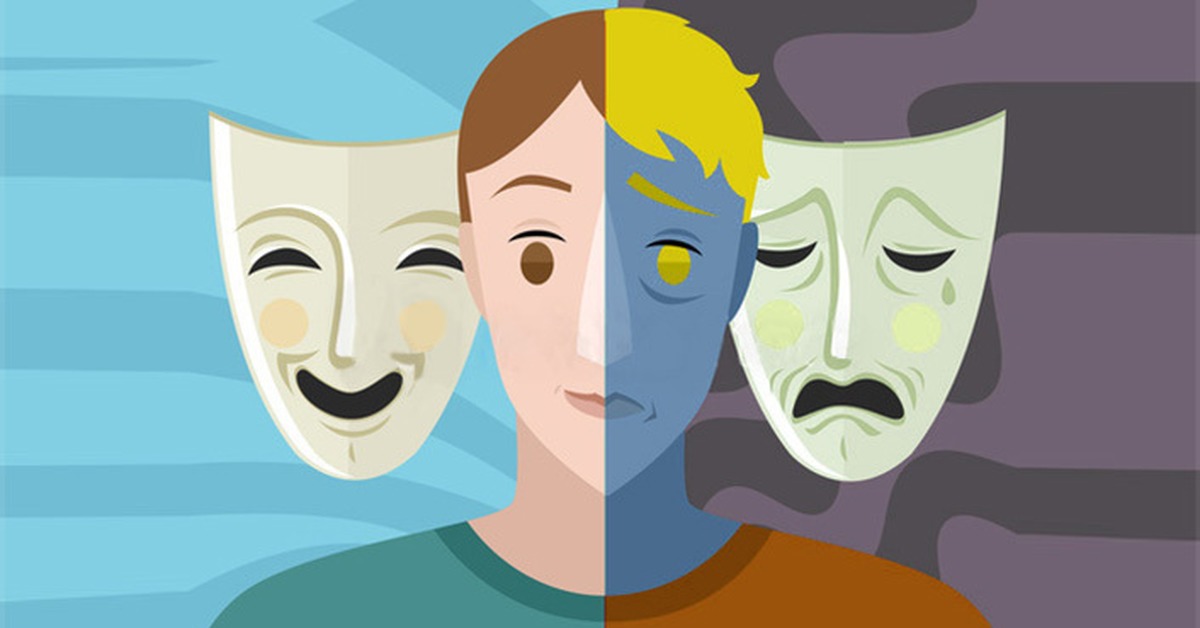 If you’re pregnant or you take other medications, be sure to tell your doctor before taking any new medications.
If you’re pregnant or you take other medications, be sure to tell your doctor before taking any new medications.
Writing in a diary can be an especially helpful part of your treatment. Keeping track of your moods, sleeping and eating patterns, and significant life events can help you and your doctor understand how therapy and medications are working.
If your symptoms don’t improve or get worse, your doctor may order a change in your medications or a different type of psychotherapy.
Online therapy options
Read our review of the best online therapy options to find the right fit for you.
Bipolar disorder isn’t curable. But with proper treatment and support from family and friends, you can manage your symptoms and maintain your quality of life.
It’s important that you follow your doctor’s instructions regarding medications and other lifestyle choices. This includes:
- alcohol use
- drug use
- exercise
- diet
- sleep
- stress reduction
Including your friends and family members in your care can be especially helpful.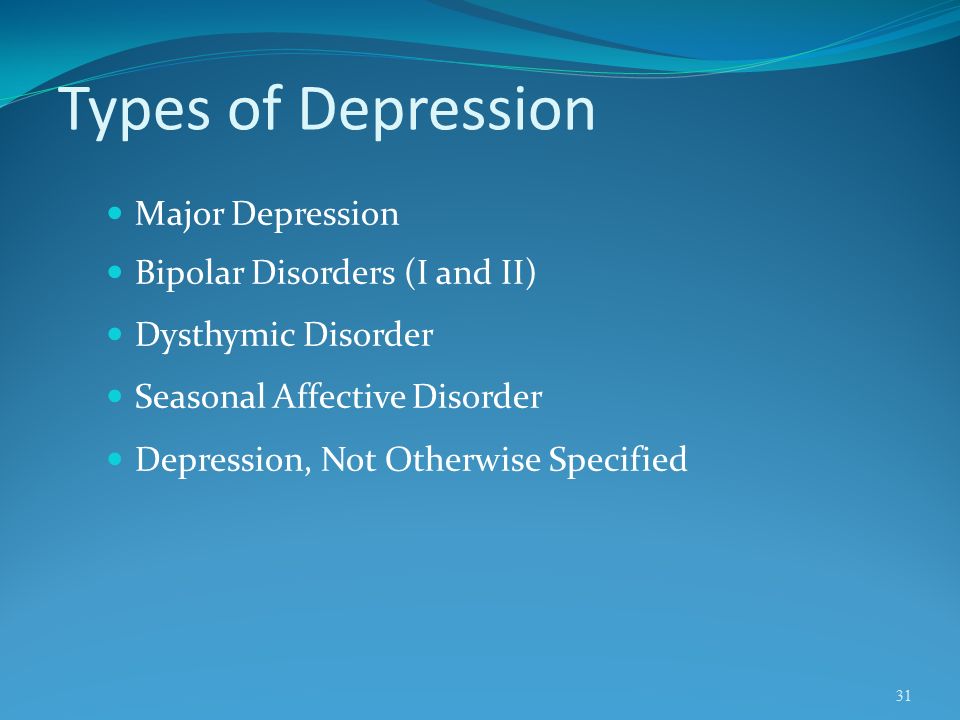
It’s also helpful to learn as much as you can about bipolar disorder. The more you know about the condition, the more in control you may feel as you adjust to life after diagnosis.
You may be able to repair strained relationships. Educating others about bipolar disorder may make them more understanding of hurtful events from the past.
Support groups, both online and in person, can be helpful for people with bipolar disorder. They can also be beneficial for your friends and relatives. Learning about others’ struggles and triumphs may help you get through any challenges you may have.
The Depression and Bipolar Support Alliance maintains a website that provides:
- personal stories from people with bipolar disorder
- contact information for support groups across the United States
- information about the condition and treatments
- material for caregivers and loved ones of those with bipolar disorder
The National Alliance on Mental Illness can also help you find support groups in your area. Good information about bipolar disorder and other conditions can also be found on its website.
Good information about bipolar disorder and other conditions can also be found on its website.
If you’ve been diagnosed with bipolar 1 or bipolar 2, you should always remember that this is a condition you can manage. You aren’t alone. Talk to your doctor or call a local hospital to find out about support groups or other local resources.
Bipolar affective disorder (BAD), its signs, types and methods of treatment
Manifestations of various emotions, a change in a person's mood, manifestations of both sadness and joy are normal and depend on many factors - from temperament and character to ongoing events that influence from the outside. However, when these changes are excessive, often unexpected and for no apparent reason, emotions get out of control, or a person remains in a radically positive or negative mood for a long time, it is very likely that bipolar disorder can be diagnosed. This disease was first described at the end of 19century, the famous German psychiatrist Emil Kripelin, calling it manic-depressive psychosis.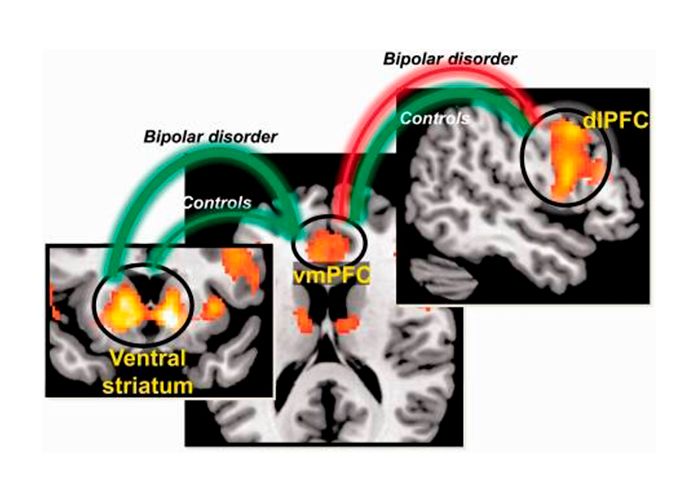 Many world famous personalities such as Vincent van Gogh, Isaac Newton, Ludwig van Beethoven, Abraham Lincoln suffered from this disease. A pronounced form of this disease, which is called bipolar affective disorder (BAD) in the international classification of diseases, is detected in 3% of the world's population.
Many world famous personalities such as Vincent van Gogh, Isaac Newton, Ludwig van Beethoven, Abraham Lincoln suffered from this disease. A pronounced form of this disease, which is called bipolar affective disorder (BAD) in the international classification of diseases, is detected in 3% of the world's population.
TABLE OF CONTENTS
- 1. Bipolar Personality Disorder - Overview
- 2. Symptoms and signs
- 3. Types of bipolar disorder
- 4. Phases of Bipolar Disorder
- 5. Bipolar disorder in women
- 6. Treatment of Bipolar Personality Disorder
It is not uncommon for women to be treated with a combination of drug therapy and cognitive behavioral or interpersonal therapy with a psychotherapist.
Bipolar personality disorder - general information
According to statistics, bipolar disorder affects people between 14 and 44 years of age. Unlike adults, children and adolescents experience more frequent mood swings from mania to depression, sometimes several times a day.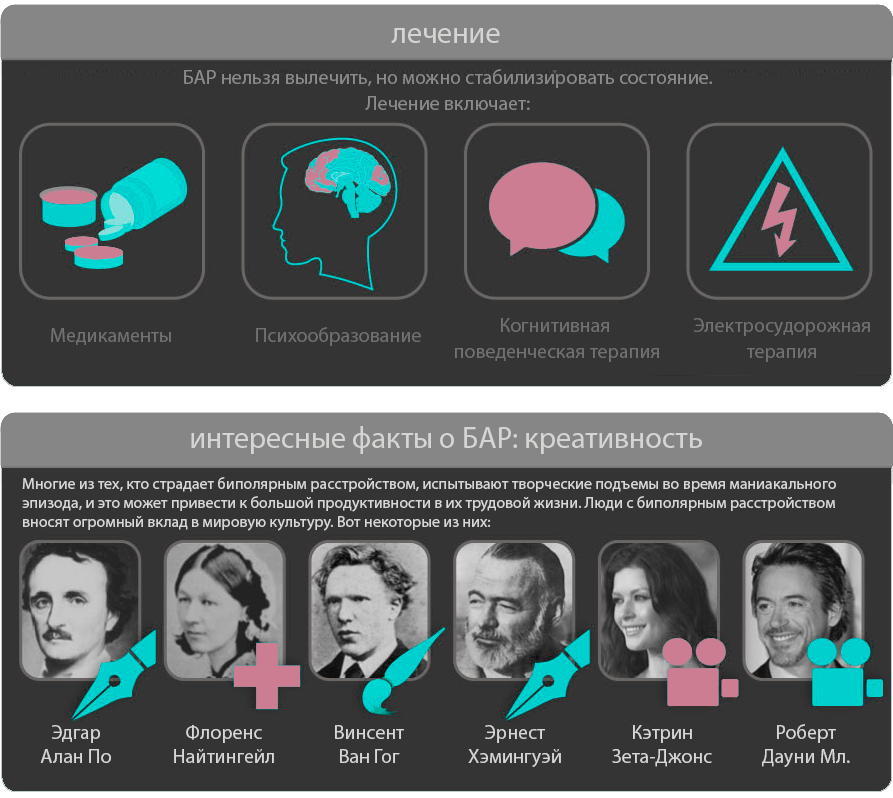 90% of young people make their debut precisely from the phase of depression or melancholy. Another feature of bipolar disorder is that, due to the low level of diagnosis, the patient can live with this disease for 5-10 years without knowing the cause of the painful symptoms.
90% of young people make their debut precisely from the phase of depression or melancholy. Another feature of bipolar disorder is that, due to the low level of diagnosis, the patient can live with this disease for 5-10 years without knowing the cause of the painful symptoms.
Most often, bipolar disorder is diagnosed in people whose immediate family members have had a similar problem. The causes of this disease are unknown, but stress, overstrain, and various diseases can provoke the manifestation of its symptoms. However, having fenced off a person from the influence of these factors, it is impossible to get rid of the problem, you need to seek help from a psychotherapist.
Bipolar disorder is a disease that cannot be completely cured. But with properly selected medication and psychotherapy, the quality of life is significantly improved and the periods between phases are lengthened. The person remains socialized and able to work.
Symptoms and signs
From the name it is clear that we are talking about two different poles of affective manifestations, that is, mood manifestations. One of these conditions is depression. Depression in bipolar disorder is pronounced, with vivid symptoms. It can last up to a year and is manifested not only by low mood, lack of ability to enjoy and interest in ongoing events, but also by psychosis, when ideas of self-accusation arise, the patient feels inferior, unnecessary, poisoning the life of others. There are also nihilistic thoughts about suffering from some kind of severe illness, despite medical evidence to the contrary. There may be delusional thoughts, as well as suicidal thoughts and even attempts.
One of these conditions is depression. Depression in bipolar disorder is pronounced, with vivid symptoms. It can last up to a year and is manifested not only by low mood, lack of ability to enjoy and interest in ongoing events, but also by psychosis, when ideas of self-accusation arise, the patient feels inferior, unnecessary, poisoning the life of others. There are also nihilistic thoughts about suffering from some kind of severe illness, despite medical evidence to the contrary. There may be delusional thoughts, as well as suicidal thoughts and even attempts.
The other pole of bipolar disorder is a hypomanic state or hypomania, the characteristic features of which are an increased euphoric emotional background, the patient is constantly on the move, hyperactive, and is distinguished by very fast, associative speech. The patient is constantly cheerful, often hypersexual, almost always awake or sleeping 2-3 hours a day.
Hypomania is often followed by a manic bipolar state with psychotic manifestations.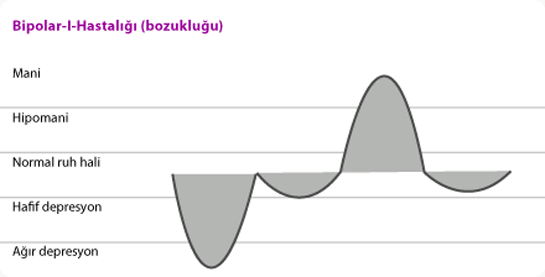 The patient develops convictions in his own greatness, he believes that he is capable of anything, feels that he has a special calling in this world or that he is a descendant of great people. In extended manic episodes of mania with psychotic manifestations, anger, irritability, and direct aggression often occur. This condition leads the patient into extremely unpleasant and sometimes dangerous situations.
The patient develops convictions in his own greatness, he believes that he is capable of anything, feels that he has a special calling in this world or that he is a descendant of great people. In extended manic episodes of mania with psychotic manifestations, anger, irritability, and direct aggression often occur. This condition leads the patient into extremely unpleasant and sometimes dangerous situations.
In addition to the typical symptoms of the disease, there are a large number of comorbid mental disorders. Comorbid mental disorders are those that accompany the underlying disease. The most common disorder of this kind is anxiety, which is manifested, among other things, by nonspecific autonomic symptoms, including sweating, palpitations, tremors of the limbs, various disorders of the gastrointestinal tract, dizziness, headaches, suffocation, and many others. In the case when these symptoms occur suddenly, mainly in public places, they are called panic attacks.
Types of Bipolar Disorder
Bipolar disorder can be Ι and ΙΙ types.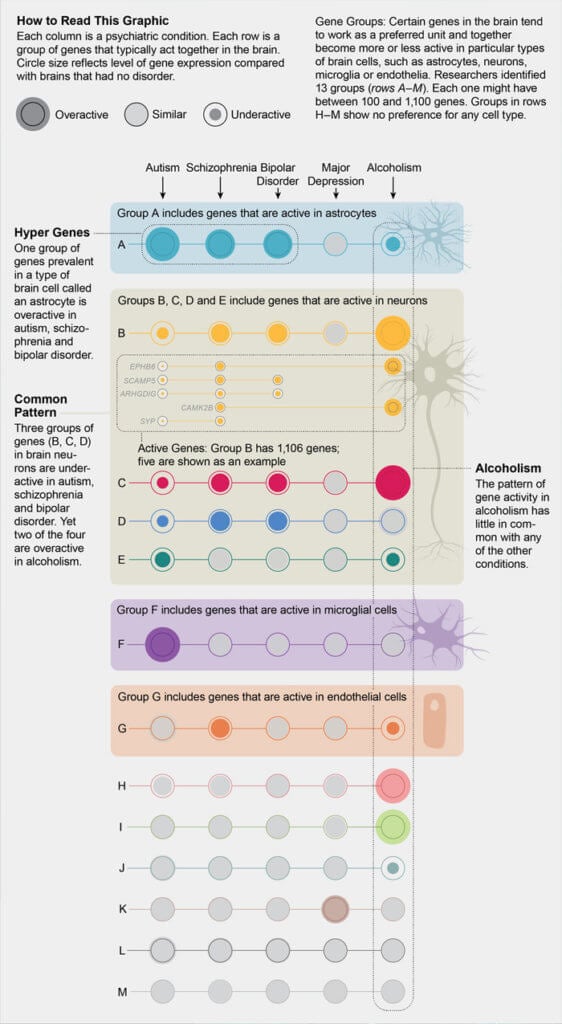
Bipolar I disorder is a condition in which the patient has persistent manias, i.e. overexcitation, enthusiastic inappropriate behavior, manic psychosis, as well as severe depressions. Symptoms of this type are more severe, so hospitalization is indicated in most cases.
Bipolar I disorder is characterized by short periods of hypomania followed by periods of deep depression. Hypomania is a pre-manic state with less active manifestations. Hypomania lasts a very short period of time - from several days to several hours, so sometimes patients do not even notice them and do not inform the doctor about it. Only careful, painstaking work with the patient makes it possible to identify hypomania, make the correct diagnosis and prescribe treatment.
Phases of bipolar disorder
There are several phases of bipolar personality disorder:
- Depressive (unipolar depression). People experience a depressed mood, despair and despondency, complain of a lack of energy and mental concentration, they can either eat too much or too little and sleep.
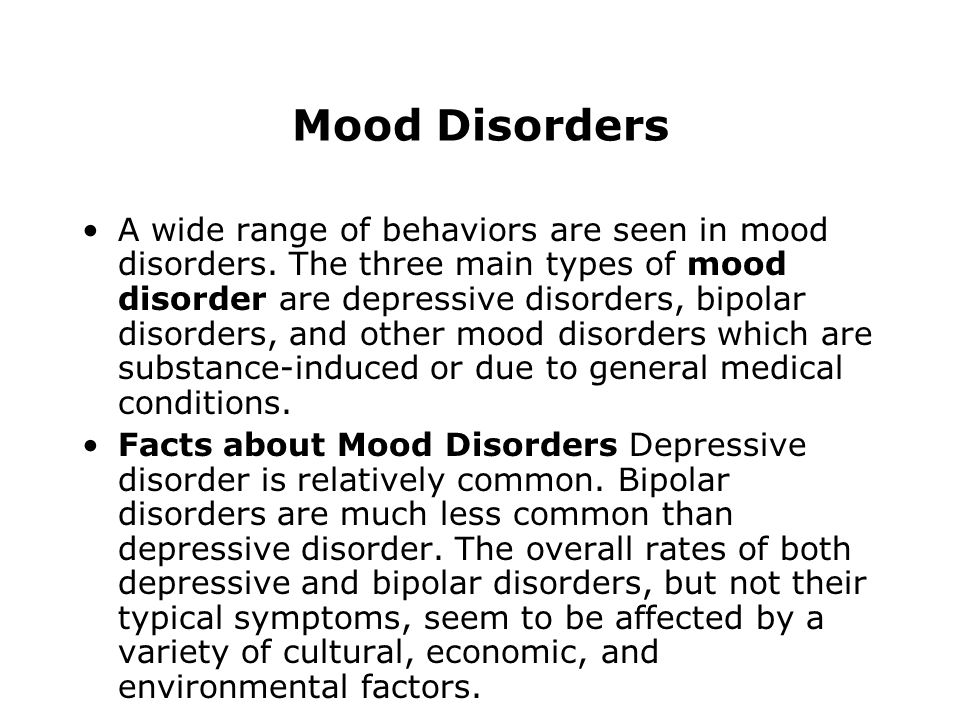
Depersonalization and derealization may occur at the peak of bipolar depressive disorder. The boundaries of their own "I" and the world around them become blurred, patients experience difficulties in perceiving what is happening. Familiar places seem new, the colors of the surrounding world change, the patient constantly experiences a feeling of "déjà vu". Sounds become muffled, even if someone is talking very close, it seems to the patient that the voice is coming from afar.
- Manic (hypomanic). In this state, patients are full of energy, overly happy or optimistic, euphoric, and have extremely high self-esteem. At first glance, these are positive signs, but when a person experiences large-scale manic episodes, these symptoms and such an emotional state can reach dangerous extremes. A patient in this phase may indiscriminately spend huge amounts of money or behave carelessly, not realizing the full danger. In conversation, people may choke on words, speak at a high speed, or jump from one thought to another.
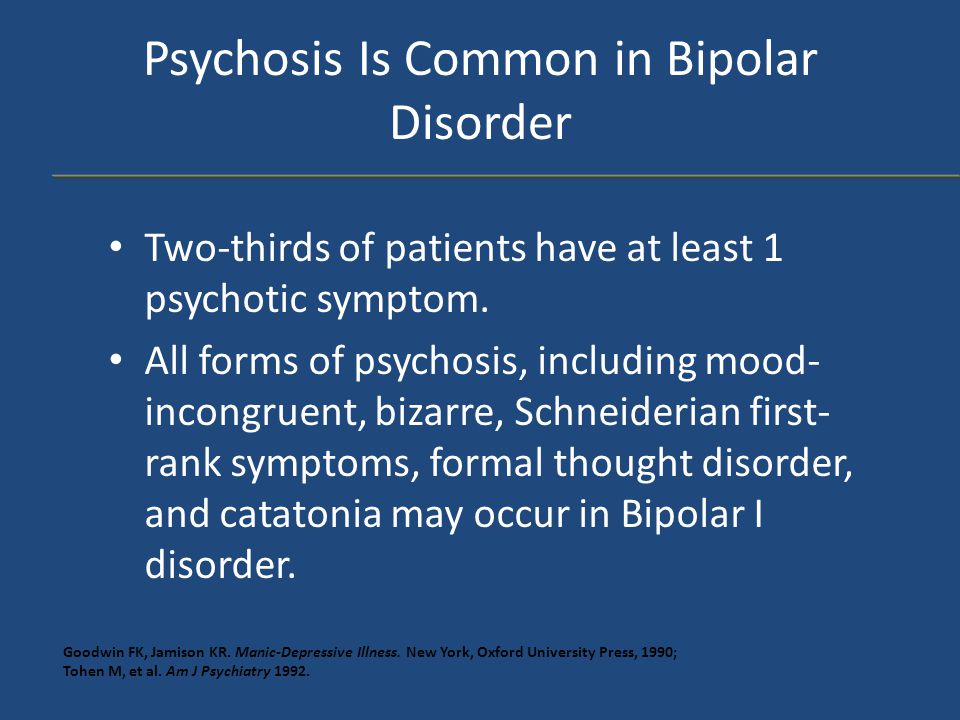 These episodes may also be accompanied by delusions of grandeur or the adoption of serious decisions without thinking about the further consequences.
These episodes may also be accompanied by delusions of grandeur or the adoption of serious decisions without thinking about the further consequences.
In the development of the manic phase, the following stages of development can be distinguished:
- Hypomania - increased excitement, emotional upsurge.
- Mania - all signs are more pronounced, aggression, irritability, irascibility and rage are possible.
- Phase peak. The patient constantly experiences nervous excitement, he cannot relax. All his emotions are "heated" to the limit, coordination of movements is disturbed, thoughts are illogical and abrupt, in speech he constantly jumps from one sentence to another.
- Relief of symptoms. The patient gradually calms down. Movement disorders are on the decline. The speed of thinking and increased emotional mood remain unchanged.
- Return to normal.
- Mixed. Sometimes people have complaints that are characteristic of both depression and mania at the same time.
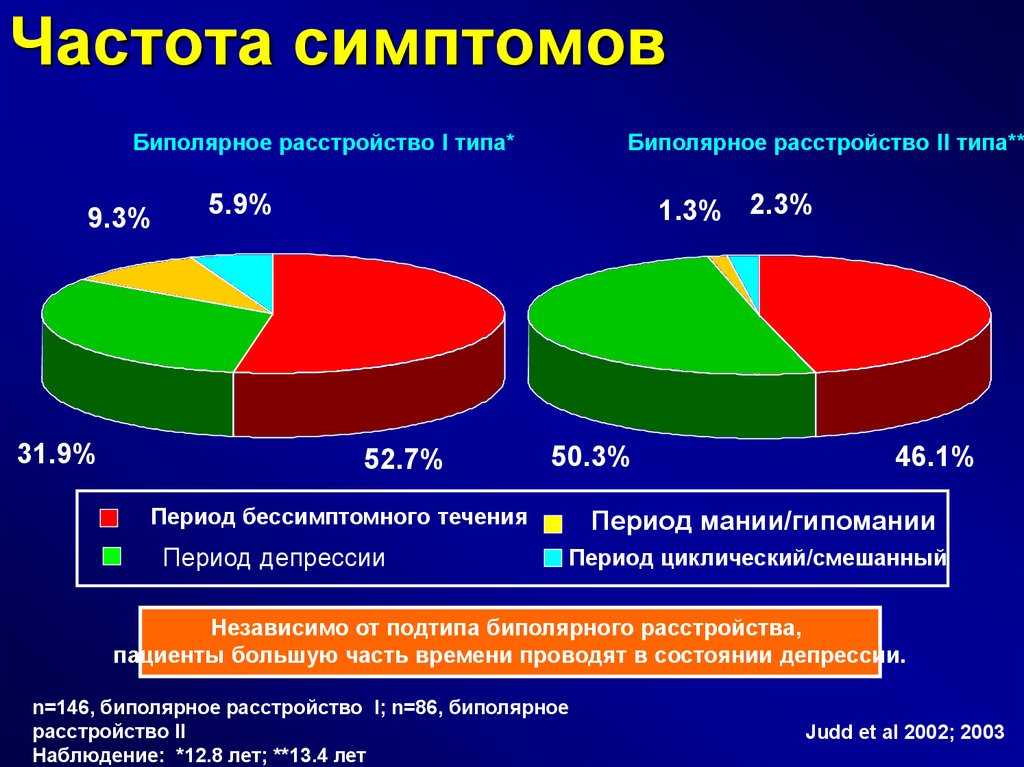 They may also experience frequent phasing—4 or more episodes in one year.
They may also experience frequent phasing—4 or more episodes in one year.
In the intervals between depressive and manic phases in bipolar disorder, there is a light period during which the general background of mood becomes relatively stable, the person continues to adequately respond to certain events, the emotional sphere is under his control. This is the main criterion for remission of bipolar disease.
Bipolar disorder in women
According to statistics, bipolar Ι disorder occurs with the same frequency in men and women, and type ΙΙ disease is more often diagnosed in women. It is also known that the female course of the disease is characterized by rapid cycles and mixed episodes. Comorbidities often include eating disorders, borderline personality disorder, alcohol or drug addiction, and psychotropic drug abuse. Women are more susceptible to such somatic diseases as migraine (intense headaches), thyroid pathologies, diabetes, and obesity.
For women, a special technique is being developed to alleviate this disorder, since from adolescence to menopause there are specific changes in hormonal levels that must be taken into account.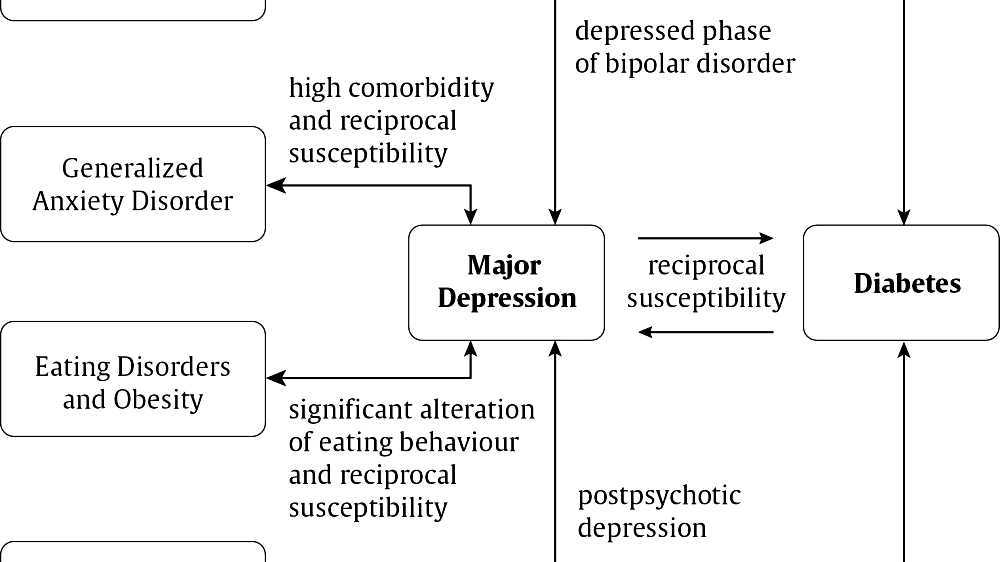 In addition, psychotropic substances, which are supposed to stabilize the condition, can adversely affect the intrauterine development of the fetus if the woman is in position. It is noted that in the first trimester of pregnancy this disorder is milder, but after childbirth they often have to deal with postpartum depression. Thus, at each stage of the development of the female body, a competent doctor must review and adjust the treatment regimen. Often in the treatment of women, a complex method is used that combines drug therapy and cognitive-behavioral or interpersonal therapy with a psychotherapist. This approach gives the fastest results.
In addition, psychotropic substances, which are supposed to stabilize the condition, can adversely affect the intrauterine development of the fetus if the woman is in position. It is noted that in the first trimester of pregnancy this disorder is milder, but after childbirth they often have to deal with postpartum depression. Thus, at each stage of the development of the female body, a competent doctor must review and adjust the treatment regimen. Often in the treatment of women, a complex method is used that combines drug therapy and cognitive-behavioral or interpersonal therapy with a psychotherapist. This approach gives the fastest results.
Treatment for bipolar disorder
Attempts to get rid of bipolar disorder on your own do not bring the desired result and, ultimately, lead to an aggravation of the situation, including the development of drug or alcohol dependence. In the diagnosis of the disease, keeping a mood diary can help, where the patient records all his thoughts, emotions, feelings, changes in mood. Such records will help the doctor to assess the mental state in detail and make the correct diagnosis. If you suspect bipolar disorder, you should consult a doctor, and the sooner a person realizes that he has a disease and comes to the clinic for help, the sooner professional help will be provided to him and painful symptoms will be replaced by a stable condition. It is impossible to get rid of the disease on your own, since a person cannot fully adequately assess not only his actions, but also the alternation of the phases of the disease.
Such records will help the doctor to assess the mental state in detail and make the correct diagnosis. If you suspect bipolar disorder, you should consult a doctor, and the sooner a person realizes that he has a disease and comes to the clinic for help, the sooner professional help will be provided to him and painful symptoms will be replaced by a stable condition. It is impossible to get rid of the disease on your own, since a person cannot fully adequately assess not only his actions, but also the alternation of the phases of the disease.
Bipolar disorder is one of the few mental disorders in which medication is indicated in 100% of cases, and psychotherapy is an auxiliary tool. This disease is incurable, but its diagnosis and treatment is extremely important. Treatment can reduce the number of episodes, their severity and intensity, as well as prevent negative life events, help prevent relationship breakups, job loss, and even suicidal attempts. Thus, the quality of life of a patient with bipolar disorder who is undergoing treatment will be several times higher than that of a person who neglects treatment.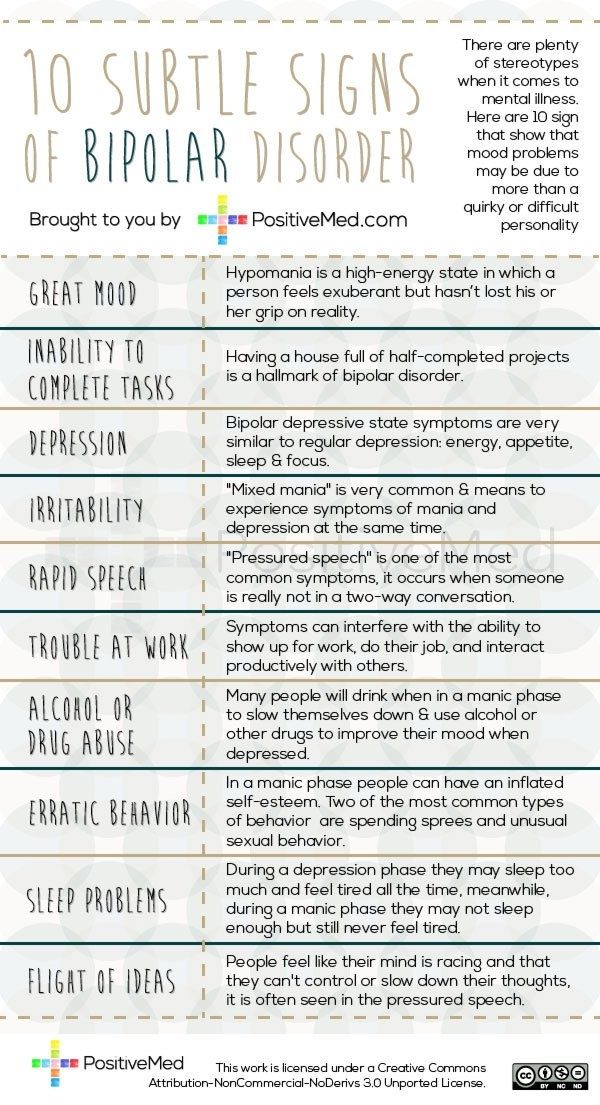 If the patient loses touch with reality and harms himself and others, he is subject to hospitalization, outpatient treatment in this case is not permissible.
If the patient loses touch with reality and harms himself and others, he is subject to hospitalization, outpatient treatment in this case is not permissible.
If you have a disease, it is recommended to exclude coffee, strong tea, alcoholic and energy drinks from your diet in order not to provoke an overexcited state. If possible, you should stop smoking and in no case should you take even soft drugs. It is also very important to establish a sleep pattern, sleep at least 8 hours a day and try to go to bed at about the same time. You should learn to recognize mood swings and notice the early manifestations of new episodes.
If you suspect that you have bipolar personality disorder, there is no need to panic, only a doctor can diagnose the disease, so you need to make an appointment with a psychotherapist with extensive experience in managing such patients at our MedAstrum clinic. If the diagnosis is confirmed, the doctor will make the necessary medication, if necessary, prescribe psychotherapeutic sessions and give recommendations for further lifestyle adjustments.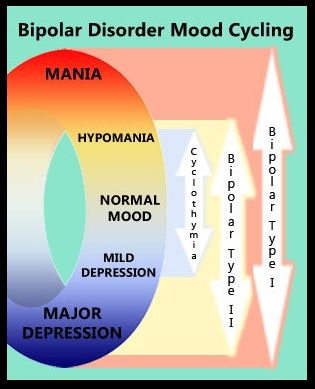 You can make an appointment yourself on the website or by contacting our administrators.
You can make an appointment yourself on the website or by contacting our administrators.
You might be interested
Autumn depressionBipolar disorder | Symptoms, complications, diagnosis and treatment
Bipolar disorder, formerly called manic depression, is a mental health condition that causes extreme mood swings that include emotional highs (mania or hypomania) and lows (depression). Episodes of mood swings may occur infrequently or several times a year.
When you become depressed, you may feel sad or hopeless and lose interest or pleasure in most activities. When the mood shifts to mania or hypomania (less extreme than mania), you may feel euphoric, full of energy or unusually irritable. These mood swings can affect sleep, energy, alertness, judgment, behavior, and the ability to think clearly.
Although bipolar disorder is a lifelong condition, you can manage your mood swings and other symptoms by following a treatment plan. In most cases, bipolar disorder is treated with medication and psychological counseling (psychotherapy).
In most cases, bipolar disorder is treated with medication and psychological counseling (psychotherapy).
Symptoms
There are several types of bipolar and related disorders. They may include mania, hypomania, and depression. Symptoms can lead to unpredictable changes in mood and behavior, leading to significant stress and difficulty in life.
- Bipolar disorder I. You have had at least one manic episode, which may be preceded or accompanied by hypomanic or major depressive episodes. In some cases, mania can cause a break with reality (psychosis).
- Bipolar disorder II. You have had at least one major depressive episode and at least one hypomanic episode, but never had a manic episode.
- Cyclothymic disorder. You have had at least two years - or one year in children and adolescents - many periods of hypomanic symptoms and periods of depressive symptoms (though less severe than major depression).

- Other types. These include, for example, bipolar and related disorders caused by certain drugs or alcohol or due to health conditions such as Cushing's disease, multiple sclerosis or stroke.
Bipolar II is not a milder form of Bipolar I but is a separate diagnosis. Although bipolar I manic episodes can be severe and dangerous, people with bipolar II can be depressed for longer periods of time, which can cause significant impairment.
Although bipolar disorder can occur at any age, it is usually diagnosed in adolescence or early twenties. Symptoms can vary from person to person, and symptoms can change over time.
Mania and hypomania
Mania and hypomania are two different types of episodes, but they share the same symptoms. Mania is more pronounced than hypomania and causes more noticeable problems at work, school, and social activities, as well as relationship difficulties. Mania can also cause a break with reality (psychosis) and require hospitalization.
Both a manic and a hypomanic episode include three or more of these symptoms:
- Abnormally optimistic or nervous
- Increased activity, energy or excitement
- Exaggerated sense of well-being and self-confidence (euphoria)
- Reduced need for sleep
- Unusual talkativeness
- Distractibility
- Poor decision-making - for example, in speculation, in sexual encounters, or in irrational investments
Major depressive episode
Major depressive episode includes symptoms that are severe enough to cause noticeable difficulty in daily activities such as work, school, social activities, or relationships. Episode includes five or more of these symptoms:
- Depressed mood, such as feeling sad, empty, hopeless, or tearful (in children and adolescents, depressed mood may present as irritability)
- Marked loss of interest or feeling of displeasure in all (or nearly all) activities
- Significant weight loss with no diet, weight gain, or decreased or increased appetite (in children, failure to gain weight as expected may be a sign of depression)
- Either insomnia or sleeping too much
- Either anxiety or slow behavior
- Fatigue or loss of energy
- Feelings of worthlessness or excessive or inappropriate guilt
- Decreased ability to think or concentrate, or indecisiveness
- Thinking, planning or attempting suicide
Other features of bipolar disorder
Signs and symptoms of bipolar I and bipolar II disorder may include other signs such as anxiety disorder, melancholia, psychosis, or others.


